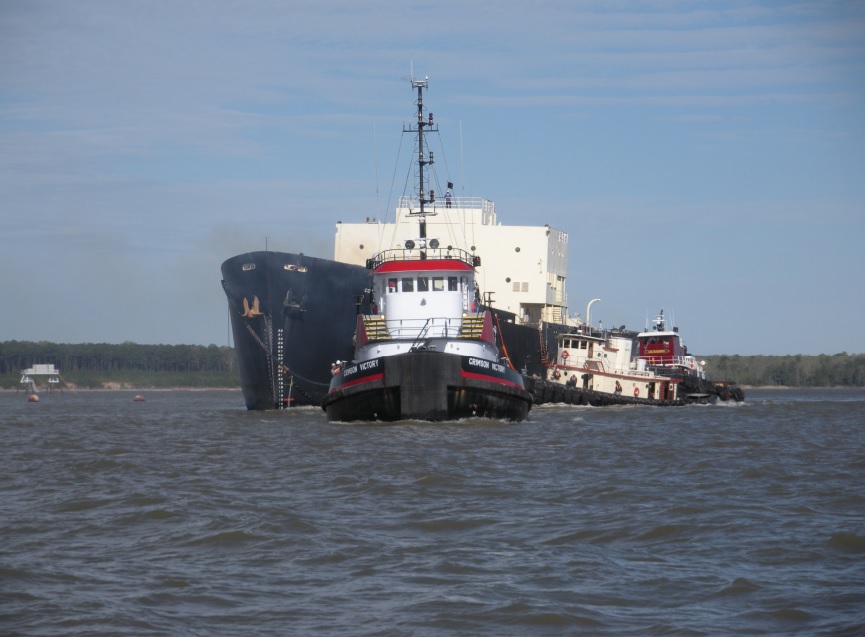This extremely unusual vessel was built for the US Army in the 1960s to provide a mobile, sea-side nuclear power plant (rated at 10 MWe). It operated at the Panama Canal from 1968 through 1976, when it was rendered redundant by installation of other generating assets. The ship was nominally converted from the Liberty Ship SS Charles Cugle, but in point of fact the mid-body of the ship, including a 350-ton containment vessel, was fabricated new and inserted between the (re-used) ends of the Cugle.
After being brought back to the United States from Panama, the Sturgis was essentially redundant and was defueled at Fort Belvoir, Virginia (where the Army had other nuclear facilities), in the summer of 1977. Full preparation for SAFSTOR (Safe Storage, in advance of a future dismantling date) was performed on the ship in Savannah, Georgia, in 1978 and then the ship was moved to the James River Reserve Fleet, where it stayed, with the exception of several trips to dry dock for maintenance, until today.

Nuclear barge
Sturgis, long since shut down and in SAFSTOR, prepares to be towed off on the morning of April 16, 2015. Photo courtesy NS SAVANNAH ASSOCIATION, INC.
Nuclear barge Sturgis, long since shut down and in SAFSTOR, prepares to be towed off on the morning of April 16, 2015. Photo courtesy NS SAVANNAH ASSOCIATION, INC.
In recent years, the Army Corps of Engineers has reviewed its several miscellaneous nuclear licenses and among these found, naturally, that the Sturgis was surplus, and that there were no anticipated needs for the ship. Keeping the ship mothballed only led to advanced expense; predictably, the plans were made to have the ship towed off for dismantling, and contracts were awarded last year.
According to the Army Corps of Engineers, the journey to Galveston will take until about the week of May 11, where Chicago Bridge & Iron will begin work on decommissioning and scrapping the ship under contract. After that, preparatory work on the Sturgis will continue through the end of June. Actual radiological work on the defueled and mothballed nuclear power plant section will begin in July. The nuclear portion of the ship will be dismantled by CB&I at Malin International Shipyard, and then the rest of the ship will actually be scrapped at Brownsville, Texas, in a process that the Army Corps believes should take not more than four years from start to finish.
Below, a poignant photo as the Sturgis begins its final sea voyage of 1,750 miles to Galveston, Texas.
 Sturgis
Sturgis heads out to sea under tow about half past 9 AM, April 16, 2015. Photo courtesy NS SAVANNAH ASSOCIATION, INC.
Sturgis heads out to sea under tow about half past 9 AM, April 16, 2015. Photo courtesy NS SAVANNAH ASSOCIATION, INC.
----------
Click here to read today's US Army Corps of Engineers press release. Link includes videos of Sturgis.
Almost exactly one year ago, ANS Nuclear Cafe reported that Sturgis would go to scrap. Click here.
----------
 Will Davis is Communications Director, historian, newsletter editor and board member for the N/S Savannah Association, Inc. He is a consultant to the Global America Business Institute, a contributing author for Fuel Cycle Week, and writes his own popular blog Atomic Power Review. Davis is also a consultant and writer for the American Nuclear Society, and serves on the ANS Communications Committee. He is a former US Navy reactor operator, qualified on S8G and S5W plants.
Will Davis is Communications Director, historian, newsletter editor and board member for the N/S Savannah Association, Inc. He is a consultant to the Global America Business Institute, a contributing author for Fuel Cycle Week, and writes his own popular blog Atomic Power Review. Davis is also a consultant and writer for the American Nuclear Society, and serves on the ANS Communications Committee. He is a former US Navy reactor operator, qualified on S8G and S5W plants.
 Tugs prepare to start the former nuclear barge Sturgis on the final voyage this morning, April 16, 2015. Photo courtesy NS SAVANNAH ASSOCIATION, INC.
Tugs prepare to start the former nuclear barge Sturgis on the final voyage this morning, April 16, 2015. Photo courtesy NS SAVANNAH ASSOCIATION, INC.

 Nuclear barge Sturgis, long since shut down and in SAFSTOR, prepares to be towed off on the morning of April 16, 2015. Photo courtesy NS SAVANNAH ASSOCIATION, INC.
Nuclear barge Sturgis, long since shut down and in SAFSTOR, prepares to be towed off on the morning of April 16, 2015. Photo courtesy NS SAVANNAH ASSOCIATION, INC. Sturgis heads out to sea under tow about half past 9 AM, April 16, 2015. Photo courtesy NS SAVANNAH ASSOCIATION, INC.
Sturgis heads out to sea under tow about half past 9 AM, April 16, 2015. Photo courtesy NS SAVANNAH ASSOCIATION, INC. Will Davis is Communications Director, historian, newsletter editor and board member for the N/S Savannah Association, Inc. He is a consultant to the Global America Business Institute, a contributing author for Fuel Cycle Week, and writes his own popular blog
Will Davis is Communications Director, historian, newsletter editor and board member for the N/S Savannah Association, Inc. He is a consultant to the Global America Business Institute, a contributing author for Fuel Cycle Week, and writes his own popular blog 